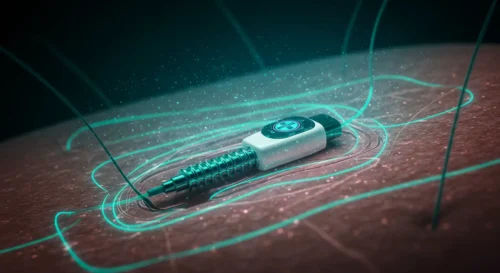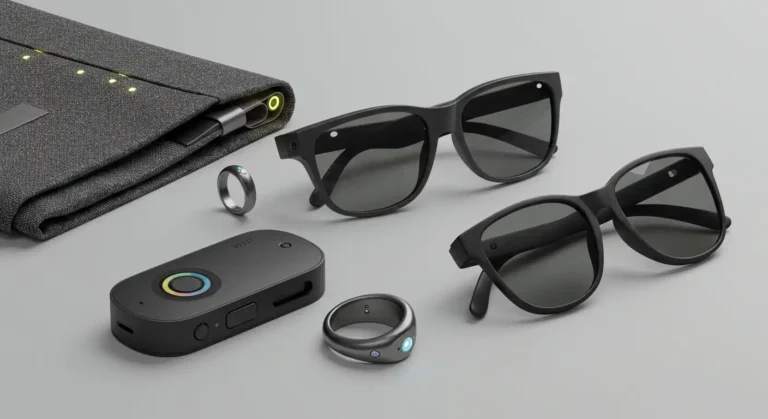The Latest in Wearable Tech: Smart Rings, AR Glasses, and More
I. Introduction:
Did you know that the global wearable technology market is projected to reach hundreds of billions of dollars in the coming years? This explosive growth is driven by our increasing desire to seamlessly integrate technology into our daily lives. From monitoring our fitness to staying connected, wearable devices are becoming an indispensable part of our routines. Imagine a ring that not only adorns your finger but also tracks your sleep quality and even allows you to make contactless payments, or glasses that overlay digital information onto your real-world view, providing instant navigation and access to information. These are not futuristic fantasies; they are the reality of today’s rapidly evolving wearable tech landscape.
The concept of wearable technology isn’t entirely new. Early examples include simple pedometers for counting steps and wristwatches for telling time. However, the advent of microelectronics, advanced sensors, and wireless communication technologies has propelled wearable tech to new heights. The introduction of the first smartwatches and fitness trackers marked a significant turning point, paving the way for a diverse range of devices that seamlessly blend fashion and functionality.
Today, the wearable tech market is experiencing a surge of innovation, with new form factors and functionalities emerging at an unprecedented pace. Beyond traditional smartwatches and fitness bands, we are witnessing the rise of smart rings, AR glasses, smart clothing, and even implantable devices. This article will delve into the latest trends in wearable technology, focusing on the exciting potential of smart rings, AR glasses, and other emerging wearables that are poised to revolutionize how we interact with the world around us.
II. Smart Rings: Small Size, Big Potential

Smart rings represent a fascinating evolution in wearable technology, packing a surprising amount of functionality into a small and discreet form factor. Unlike bulkier smartwatches or fitness bands, smart rings offer a more subtle and stylish way to track your health, manage your digital life, and even make payments. Their compact size contributes to their convenience and comfort, making them suitable for continuous wear, even during sleep.
Key Functions of Smart Rings:
Despite their small size, smart rings offer a wide range of features, often overlapping with those found in other wearables:
- Activity Tracking: Like fitness trackers, smart rings can monitor your daily activity levels, including steps taken, distance traveled, calories burned, and active minutes. This data can help you track your fitness progress and maintain a healthy lifestyle.
- Sleep Tracking: One of the key strengths of smart rings is their ability to accurately track sleep patterns. They can monitor sleep stages (light, deep, REM), heart rate variability (HRV), and body temperature to provide detailed insights into your sleep quality. This data can be valuable for identifying sleep disturbances and improving sleep hygiene.
- Health Monitoring: Beyond sleep and activity tracking, some smart rings can also monitor other vital signs, such as resting heart rate, blood oxygen saturation (SpO2), and even body temperature fluctuations, which can be useful for early detection of potential health issues.
- Contactless Payments: Some smart rings integrate NFC technology, allowing you to make contactless payments at compatible terminals, just like a contactless credit card or a smartphone. This offers a convenient and secure way to pay for goods and services without needing to take out your wallet or phone.
- Device Control: Some smart rings can be used to control other devices, such as smartphones, smart home appliances, or even computers. This can be useful for tasks like controlling music playback, adjusting smart lighting, or navigating presentations.
Examples and Key Features:
Several companies are developing innovative smart rings, each with its own unique features and focus:
- Oura Ring: The Oura Ring is perhaps the most well-known smart ring, focusing primarily on sleep and recovery tracking. It provides detailed sleep analysis, including sleep stages, heart rate variability, and body temperature. It also offers insights into your daily activity levels and overall health.
- Circular Ring: The Circular Ring also focuses on health and wellness tracking, offering similar features to the Oura Ring, including sleep tracking, activity tracking, and heart rate monitoring. It also includes features like blood oxygen saturation (SpO2) monitoring.
- Other Examples: The smart ring market is constantly evolving, with new players and innovative features emerging regularly. Some other examples include rings that focus on style and fashion, incorporating precious metals and gemstones, while others prioritize specific functionalities, such as contactless payments or gesture control.
Smart rings offer a compelling combination of style, convenience, and functionality, making them an attractive alternative to other wearable devices. As technology continues to advance, we can expect to see even more innovative features and applications emerge in the future.
III. AR Glasses: Blending the Real and Digital Worlds

Augmented reality (AR) glasses represent a significant leap forward in wearable technology, seamlessly blending the digital and physical worlds. Unlike virtual reality (VR), which creates entirely immersive virtual environments, AR overlays digital information and virtual objects onto the user’s real-world view. This allows users to interact with both the physical and digital worlds simultaneously, enhancing their perception and interaction with their surroundings.
AR glasses use a combination of technologies to achieve this blending of realities:
- Displays: AR glasses use various display technologies to project digital images onto the user’s field of view. These can include optical see-through displays (where the user sees the real world through transparent lenses with overlaid digital images) or video see-through displays (where cameras capture the real world and combine it with digital images on a display screen).
- Sensors: AR glasses are equipped with various sensors, such as cameras, accelerometers, gyroscopes, and GPS, to track the user’s movements and map their surroundings. This allows the digital content to be accurately positioned and aligned with the real world.
- Processing Power: AR glasses require significant processing power to render digital images, process sensor data, and run AR applications. This is often achieved through powerful onboard processors or by connecting to external devices, such as smartphones or computers.
Applications of AR Glasses:
AR glasses have a wide range of potential applications across various industries:
- Gaming: AR games can overlay virtual objects and characters onto the real world, creating immersive and interactive gaming experiences.
- Navigation: AR glasses can provide real-time navigation instructions, projecting directions and points of interest onto the user’s field of view.
- Industry: In industrial settings, AR glasses can provide workers with hands-free access to information, instructions, and schematics, improving efficiency and safety.
- Medicine: AR glasses can assist surgeons during complex procedures by providing real-time visualizations of patient data and anatomical structures. They can also be used for training medical professionals.
- Education: AR glasses can create interactive learning experiences, allowing students to explore historical sites, dissect virtual organisms, or visualize complex scientific concepts in 3D.
Examples and Key Features:
Several companies are developing innovative AR glasses, each with its own unique features and target market:
- Microsoft HoloLens: The Microsoft HoloLens is a powerful holographic computer built into a headset. It is primarily targeted at enterprise users and developers, offering advanced features for industrial applications, training, and collaboration.
- Magic Leap: Magic Leap One is another advanced AR headset that focuses on creating immersive mixed reality experiences. It is used in various fields, including healthcare, manufacturing, and entertainment.
- Ray-Ban Stories: Developed in partnership with Facebook (Meta), Ray-Ban Stories are smart glasses that focus on capturing photos and videos, listening to music, and making phone calls. They offer a more subtle approach to AR, focusing on enhancing everyday experiences rather than overlaying complex digital content.
- Google Glass Enterprise Edition: This version of Google Glass is designed for enterprise use, providing workers with hands-free access to information and tools in various industries, such as manufacturing, logistics, and healthcare.
AR glasses are still a relatively nascent technology, but they have the potential to transform how we interact with the world around us. As technology continues to improve and costs decrease, we can expect to see wider adoption of AR glasses in various aspects of our lives.
IV. Beyond Rings and Glasses: Other Emerging Wearables

While smart rings and AR glasses are generating significant buzz, the wearable tech landscape extends far beyond these form factors. Researchers and companies are constantly exploring new ways to integrate technology into our lives, leading to the development of other innovative wearable devices.
Smart Clothing:
Smart clothing, also known as e-textiles or smart textiles, integrates electronic components, such as sensors, conductors, and microcontrollers, directly into fabrics. This allows clothing to perform a variety of functions, such as:
- Fitness and Activity Tracking: Smart clothing can track various metrics like heart rate, breathing rate, muscle activity, and even posture. This data can be used to optimize workouts, monitor athletic performance, and prevent injuries.
- Health Monitoring: Smart garments can monitor vital signs like body temperature, skin temperature, and even detect early signs of certain medical conditions. This can be particularly useful for athletes, elderly individuals, or people with chronic health conditions.
- Environmental Monitoring: Some smart clothing can even monitor environmental factors like UV radiation exposure, air quality, and temperature, providing valuable information for outdoor activities or occupational safety.
Examples of smart clothing include sensor-embedded sports bras that track running metrics, shirts that monitor heart rate and breathing, and even socks that can detect foot pressure and prevent blisters.
Medical Implants and Sensors:
Medical implants and sensors represent another exciting area of wearable technology. These devices are designed to be implanted under the skin or within the body to continuously monitor various health parameters:
- Glucose Monitoring: Continuous glucose monitors (CGMs) are small devices implanted under the skin that track blood glucose levels in real-time. This is particularly beneficial for people with diabetes, allowing them to better manage their condition.
- Cardiac Monitoring: Implantable cardiac monitors can track heart rhythm and detect abnormalities, helping to diagnose and manage heart conditions.
- Drug Delivery: Some implantable devices can even deliver medication directly into the body, providing targeted and controlled drug delivery.
While still facing regulatory hurdles and ethical considerations, medical implants and sensors have the potential to revolutionize healthcare by providing continuous and personalized health monitoring.
Other Innovative Form Factors:
Beyond smart clothing and medical implants, other innovative wearable form factors are also emerging:
- Smart Patches: Thin, flexible adhesive patches that can be worn on the skin to monitor various health metrics, such as heart rate, temperature, and sweat composition.
- Smart Jewelry: Beyond rings, other forms of jewelry, such as necklaces and bracelets, can also incorporate sensors and other electronic components to track activity, monitor health, or provide notifications.
- Contact Lenses: Researchers are developing smart contact lenses that can monitor glucose levels in tears or even project digital information onto the user’s field of view.
The field of wearable technology is constantly evolving, with new innovations and applications emerging regularly. As technology continues to advance, we can expect to see even more creative and impactful wearable devices that seamlessly integrate into our lives.
V. The Future of Wearable Tech
The future of wearable technology promises even more seamless integration into our lives, offering a wide range of functionalities and enhancing various aspects of our daily routines. Several key trends are shaping the future of this rapidly evolving market:
Key Trends:
- Miniaturization: Devices are becoming smaller, lighter, and more discreet, allowing for more comfortable and unobtrusive wear. This trend is particularly evident in smart rings and other smaller form factors.
- Improved Battery Life: One of the main challenges of wearable tech has been battery life. Advancements in battery technology are leading to longer-lasting devices, reducing the need for frequent charging.
- AI Integration: Artificial intelligence (AI) is playing an increasingly important role in wearable tech. AI algorithms can analyze data collected by sensors to provide personalized insights, recommendations, and even predict potential health issues.
- Expanding Functionality: Wearable devices are becoming more versatile, offering a wider range of functionalities beyond basic fitness tracking. This includes advanced health monitoring, contactless payments, augmented reality experiences, and integration with other smart devices and ecosystems.
- Focus on personalization: Wearables of the future will be even more personalized, adapting to the individual user’s needs, preferences, and lifestyle. This includes personalized health recommendations, customized interfaces, and adaptive learning experiences.
- Integration with the Metaverse: Wearable devices will play a key role in accessing and interacting with the metaverse, blurring the lines between the physical and digital worlds. AR glasses and other immersive wearables will become gateways to virtual experiences, offering new ways to connect, collaborate, and learn.
Future Predictions:
Based on current trends and technological advancements, we can expect to see wider adoption of wearable tech in various sectors:
- Healthcare: Wearable devices will play an increasingly important role in remote patient monitoring, early disease detection, and personalized treatment plans.
- Sports and Fitness: Wearables will provide athletes and fitness enthusiasts with more detailed and personalized performance data, helping them to optimize their training and prevent injuries.
- Industry: Wearable devices will be used in various industries to improve worker safety, efficiency, and productivity. This includes AR glasses for hands-free access to information and smart clothing for monitoring worker health and environmental conditions.
- Everyday Life: Wearables will become even more integrated into our daily lives, providing seamless access to information, communication, entertainment, and other services.
Challenges and Opportunities:
Despite the promising future, several challenges need to be addressed:
- Data Privacy and Security: The increasing amount of personal data collected by wearable devices raises significant concerns about privacy and security. Robust security measures and clear privacy policies are essential to protect user data.
- Ethical Considerations: Ethical considerations related to data ownership, algorithmic bias, and the potential for misuse of wearable data need to be addressed.
- Cost and Accessibility: Making wearable technology more affordable and accessible to a wider population is crucial for its widespread adoption.
- Interoperability: Ensuring that wearable devices can seamlessly communicate and share data with other devices and platforms is essential for creating a cohesive and user-friendly experience.
Addressing these challenges presents significant opportunities for innovation and growth in the wearable tech market. By focusing on user privacy, ethical considerations, affordability, and interoperability, we can unlock the full potential of wearable technology and create a future where these devices enhance our lives in meaningful ways.
VI. Conclusion
The wearable technology market is experiencing a period of rapid innovation, with new form factors, functionalities, and applications emerging constantly. From discreet smart rings that track our health to immersive AR glasses that blend the real and digital worlds, wearable devices are poised to transform various aspects of our lives.
As we’ve explored, smart rings offer a convenient and stylish way to monitor health metrics and manage digital tasks. AR glasses promise to enhance our perception of the world around us, providing hands-free access to information and creating immersive augmented reality experiences. Beyond these key categories, other emerging wearables, such as smart clothing and medical implants, offer even more specialized applications in healthcare, sports, and industry.
The future of wearable tech points towards even greater personalization, seamless integration with AI and the metaverse, and a wider range of functionalities. These devices have the potential to significantly improve our health and well-being, boost productivity, enhance communication, and provide new forms of entertainment and learning. However, it is crucial to address the challenges related to data privacy, ethical considerations, cost, and interoperability to ensure that the benefits of wearable technology are accessible to everyone and used responsibly. By embracing innovation while prioritizing user privacy and ethical guidelines, we can unlock the full potential of wearable tech to create a more connected, healthy, and enriched future.
VII. Frequently Asked Questions (FAQ)
Here are some frequently asked questions about wearable technology:
-
What are the main advantages of smart rings?
Smart rings offer several advantages, including their discreet and stylish design, comfortable wear, and ability to track various health metrics, such as sleep quality, activity levels, and heart rate. Some smart rings also offer features like contactless payments and device control.
-
How do AR glasses differ from VR glasses?
AR (Augmented Reality) glasses overlay digital information onto the real world, allowing users to see and interact with both physical and virtual elements simultaneously. VR (Virtual Reality) glasses, on the other hand, create entirely immersive virtual environments that block out the real world.
-
What are the risks associated with using wearable technology?
Some potential risks associated with wearable technology include data privacy concerns (as these devices collect a lot of personal data), security vulnerabilities (if devices are not properly secured), and potential ethical issues related to data ownership and algorithmic bias.
-
What is the future of the wearable technology market?
The future of the wearable technology market is bright, with continued advancements in miniaturization, battery life, AI integration, and functionality. We can expect to see wider adoption of wearables in various sectors, including healthcare, sports, industry, and everyday life. Integration with the metaverse is also a key trend to watch.
-
How much do modern wearable devices cost?
The cost of wearable devices can vary significantly depending on the type of device, its features, and the brand. Basic fitness trackers can cost as little as $30-$50, while high-end smartwatches and AR glasses can cost several hundreds or even thousands of dollars. Smart rings typically range in price from $200 to $300 or more.

